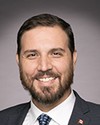Thank you very much for that, Mr. Chair.
Good afternoon, committee members.
Thank you for the invitation to appear today to discuss cybersecurity and specifically the “National Cyber Threat Assessment 2020” report released on November 18.
As the head of the Canadian Centre for Cyber Security at the Communications Security Establishment, I am very pleased to be here. CSE is Canada's foreign intelligence agency and lead technical and operational agency for cybersecurity. As was mentioned, I have appeared here a few times before.
Created in 2018, the cyber centre is a unified source of expert advice, guidance and support on cybersecurity operational matters. We work closely with other government agencies, industry partners and the public to improve cybersecurity for Canadians and to make Canada more resilient against cyber-threats.
Our goal with the national cyber-threat assessment is not to frighten Canadians or to be downers, but rather to inform all of us about the threats we will be facing in the coming years. I hope it spurs many of us to take simple actions to protect ourselves. We have seen that easy, simple actions can greatly increase our individual security.
Canada is one of the most connected countries in the world, which the NCTA highlights, and the COVID-19 pandemic has accelerated our reliance on the Internet to meet basic needs. We are increasingly leading our lives online, and at the same time threat actors continue to pursue new ways to use the Internet for malicious purposes. While this assessment does not provide specific mitigation advice, more guidance and best practices can be found on the cyber centre's website and through our “Get Cyber Safe” public awareness campaign. As I've said before, by taking even a single action, all Canadians can help shape and sustain our nation's cyber-resilience.
For those Canadians who would like to learn more, we have also published an updated “An Introduction to the Cyber Threat Environment”, which I will confess I may slip and call the “cyber primer”, in which we explain many of the terms and techniques used in cybersecurity.
The assessment analyzes cyber-trends since 2018 and draws upon the cyber centre's unique view of the cyber-threat environment to forecast those trends to around 2022. The assessment also highlights the most relevant cyber-threats to Canadian individuals and organizations.
Before I discuss those threats further, though, I would note that the assessment's findings are based on reporting from multiple classified and unclassified sources, including those related to CSE's foreign intelligence mandate. While the cyber centre must protect classified sources and methods, we have tried to provide readers with as much information as possible, including footnotes.
I'll now provide a brief breakdown of the cyber centre's key findings regarding the cyber-threat landscape. Broadly, these can be grouped into three key observations for our discussion today.
The NCTA 2020 highlights several key observations.
First, cybercrime is the threat most likely to impact Canadians now and in the years ahead, and cybercriminals often succeed because they exploit human and social behaviours.
Second, ransomware directed against Canada will almost certainly continue to target large enterprises and critical infrastructure providers.
Finally, while cybercrime is the main threat, state-sponsored cyber-programs of China, Russia, North Korea and Iran pose a strategic threat to Canada.
First, we assessed that cybercrime remains the threat most likely to impact Canadians. Now and in the years ahead Canadian individuals and organizations will continue to face online fraud and attempts to steal personal, financial and corporate information. Cybercriminals often succeed because they exploit deeply rooted human behaviours and social patterns as well as technological vulnerabilities. Unfortunately, as a result of this reality, Canadians are more at risk for cybercrime than ever. This has only increased during the COVID-19 pandemic.
Malicious cyber-actors are able to take advantage of people's heightened levels of fear to lure and encourage victims to visit fake websites, open email attachments and click on links that contain malware. These website emails and links frequently impersonate health organizations or the Government of Canada. Defending Canadians against these threats requires addressing both the technical and social elements of cyber-threat activity.
Second, the ongoing safety of Canadians depends on critical infrastructure as well as consumer and medical goods, many of which are increasingly being connected to the Internet by their manufacturers. However, once connected, these infrastructures and goods are susceptible to cyber-threats, and maintaining their security requires investments over time from manufacturers and owners that can be difficult to sustain.
We have assessed that ransomware directed at Canada will continue to target those large enterprises and critical infrastructure providers. As these entities cannot tolerate sustained disruptions, they are often willing to pay up to millions of dollars to quickly restore their operations. Many Canadian victims will likely continue to give in to ransom demands due to the severe costs of losing business and rebuilding their networks and the potential consequences of refusing payment. The protection of these organizations and networks is crucial to the productivity and competitiveness of Canadian companies, and vital for Canada's national defence.
Finally, state-sponsored actors are very likely attempting to develop cyber-capabilities to disrupt Canadian critical infrastructure to further their goals. However, we judge that it is very unlikely that cyber-threat actors will intentionally seek to disrupt critical infrastructure and cause major damage or loss of life in the absence of international hostilities. Nevertheless, cyber-threat actors may target Canadian critical organizations to collect information, pre-position for future activities, or as a form of intimidation.
While cybercrime is the most likely threat to impact the average Canadian, state-sponsored cyber-programs of China, Russia, North Korea and Iran pose the greatest strategic threat to Canada. We have assessed that state-sponsored actors will almost certainly continue to attempt to steal Canadian intellectual property, proprietary information and, in today's context, information specifically related to COVID-19.
We have also assessed that online foreign influence campaigns are no longer limited to key political events such as election periods. They are now the new normal. Adversaries now look to sustain their influence campaigns across all levels of discourse deemed to be of strategic value. While Canadians are often lower-priority targets for online foreign influence activity, our media ecosystem is closely intertwined with that of the United States and other allies, which means that when their populations are targeted, Canadians become exposed to online influence as well.
I want to reassure you that CSE and the cyber centre are working hard to mitigate many of these threats and protect Canadians and their interests through targeted advice and guidance. CSE continues to leverage all aspects of its mandate to help ensure that Canada is protected against threats. Not only is the “National Cyber Threat Assessment” meant to inform Canadians, but it is also setting the priorities for action by the cyber centre on what actions we can take, often with partners in the private sector who are willing to stand up and assist in directly addressing these threats facing each of us.
A key example of this type of partnership is the Canadian Shield initiative from the Canadian Internet Registration Authority, CIRA. CIRA Canadian Shield is a free, protected DNS service that prevents you from connecting to malicious websites that might affect your device or steal your personal information. The service is provided by the Canadian Internet Registration Authority, a not-for-profit agency that manages the “.ca” Internet domain. The service uses threat intelligence from the Canadian Centre for Cyber Security. In simple terms, if someone who is using Canadian Shield clicks on a link that is known to be malicious, they will be stopped from going to that bad site.
CIRA has seen a number of Canadians pick up the use of this tool, although we would certainly like to see it accelerated more. We are just past the six-month mark. We do recommend that all Canadians take advantage of this free service built by Canadians for Canadians and designed to protect Canadians' privacy.
Through targeted advice and guidance, the cyber centre is helping to protect Canadians' cybersecurity interests. We are dedicated to advancing cybersecurity and increasing the confidence of Canadians in the systems they rely on. We hope this report will help raise the bar in terms of awareness of today's cyber-threats. I encourage Canadians who are looking for easy-to-follow tips on cybersecurity, such as our holiday gift guide, to visit our website, GetCyberSafe.gc.ca.
For businesses and large organizations, or if you would like to read more of the publications of the cyber centre, we can be found at cyber.gc.ca.
Thank you again for the opportunity to appear before you virtually today. I'll be pleased to answer any questions you may have.












